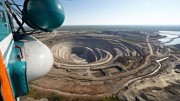Outside of the two new mines opening up in Canada — Stornoway Diamond’s Renard and De Beers and Mountain Province Diamonds’ Gahcho Kué — there hasn’t been a lot to celebrate in the diamond world of late.
In Canada, De Beers flooded its Snap Lake mine in the Northwest Territories in January. The underground mine, which has never been profitable, had been put up for sale after being put on care and maintenance last April, but failed to find a buyer. The mine was the diamond giant’s first mine outside of Africa when it opened in 2008.
In Ontario, De Beers has put an expansion of its Victor mine on hold after failing to get the support of the nearby Attawapiskat First Nation to conduct a bulk sample at the Tango kimberlite. Production from the mine is slated to end in 2018, but De Beers is studying ways to delay closing Victor by processing lower-grade stockpiles or mining deeper into the pit. It’s also considering a sale of the asset.
Meanwhile, Dominion Diamond, Canada’s largest producer and the world’s third largest diamond miner, may fall out of Canadian hands. Dominion was approached by U.S.-based Washington Corps. in February, although a formal offer wasn’t received at the time. The approach put Dominion in play, and in early May, the company reported that it had signed confidentiality agreements with interested parties including Washington Corps. In return for access to its data room. To compound its uncertain situation, the company is in the middle of a change of leadership. It’s been searching for a new president and CEO since Brendan Bell announced his resignation in January.
And it’s been far from smooth sailing in diamond market, even with a healthy increase in rough prices last year. In November, there was a big shock to the market when India’s government suddenly invalidated all 500 and 1,000 rupee notes — 86% of all the currency in circulation.
The demonetization decimated demand for smaller and lower-quality diamonds, forcing diamond miners to hold back or withdraw their smaller and lower-quality goods from sale.
But the Indian economy has remained surprisingly strong. Despite the move, India’s growth reached 7% in the last quarter of 2016 — outstripping expectations of 6.1-6.4% growth. That could mean the effect on diamond prices will be relatively short-lived, and indeed, there are early signs that India’s economy is already normalizing.
If De Beers’ sales are any sign, the market for lower-value goods is already recovering.
In its first quarter, the diamond miner sold 14.1 million carats of diamonds, up 74% from the same period a year earlier. While some of the increase was due to its holding three sales during the quarter compared with two in the same quarter of 2016, the sales allowed the miner to sell lower-value inventory it couldn’t sell late last year due to lower demand.
We don’t know how all this turmoil in the diamond world will end, and it may be a very different landscape when we see you again for our November issue. But here’s hoping we’ll have more reason than ever to celebrate Canada’s diamond sector.
This story originally appeared in the June 2017 issue of Diamonds in Canada.



Be the first to comment on "A changing landscape: Diamonds in Canada Editorial"